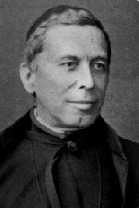Angelo Secchi, 1818-1878
Angelo Secchi was born in the Lombardian town of Reggio in 1818, just four years after the restoration of the Society of Jesus. Ordained a priest in 1847, Secchi planned to continue his training in Rome but went abroad following the tumultuous liberal revolutions of 1848. Travelling to Stonyhurst, England, and Georgetown University, Secchi taught natural science while pursuing his own interest in astronomy.
In 1849 Rome offered him the directorship of the observatory in the Roman College, a position previously held by Clavius and Boscovich. Secchi quickly implemented the latter's plan to build a new observatory on top of one of the supporting pillars of the done of the Church of St. Ignatius. Secchi's accomplishments include the re-discovery of Biela's comet in 1852; photographing the solar eclipse of 1860; using spectroscopy to learn the composition of distant stars; and the measurement and description of many binary stars and nebulae. He also invented the meteorograph, an automated device for recording barometric pressure, temperature, wind direction and velocity, and rainfall.
Works by Secchi
Le stelle saggio di astronomia siderale (Milan, 1877). an authoritative work on stellar observation and classification. It includes several color plates depicting various types of stellar spectrum.
Le soleil (Paris, 1875-1877). A popular work embodying Secchi's labors on solar phenomena. His observations of the suns' chromosphere, corona, and other features helped advance eaerly solar research. In fact, some of Secchi's descriptive terminology is still in use today.
